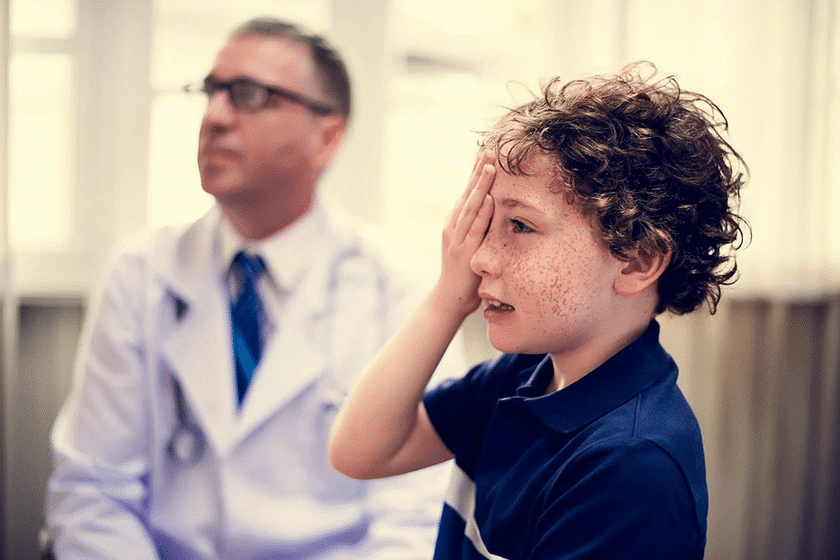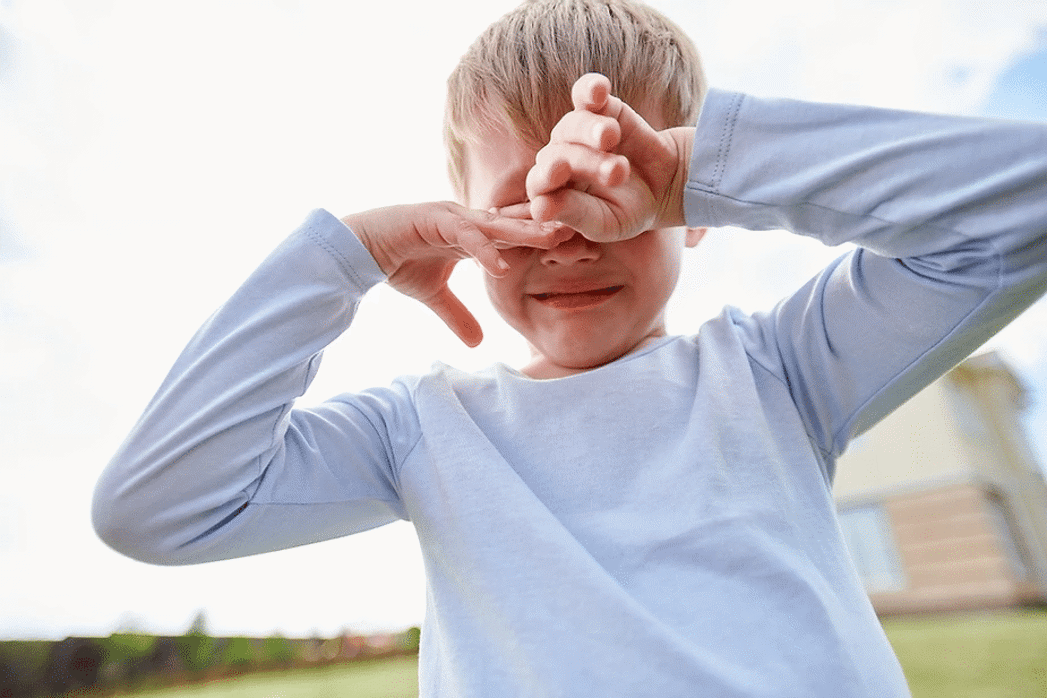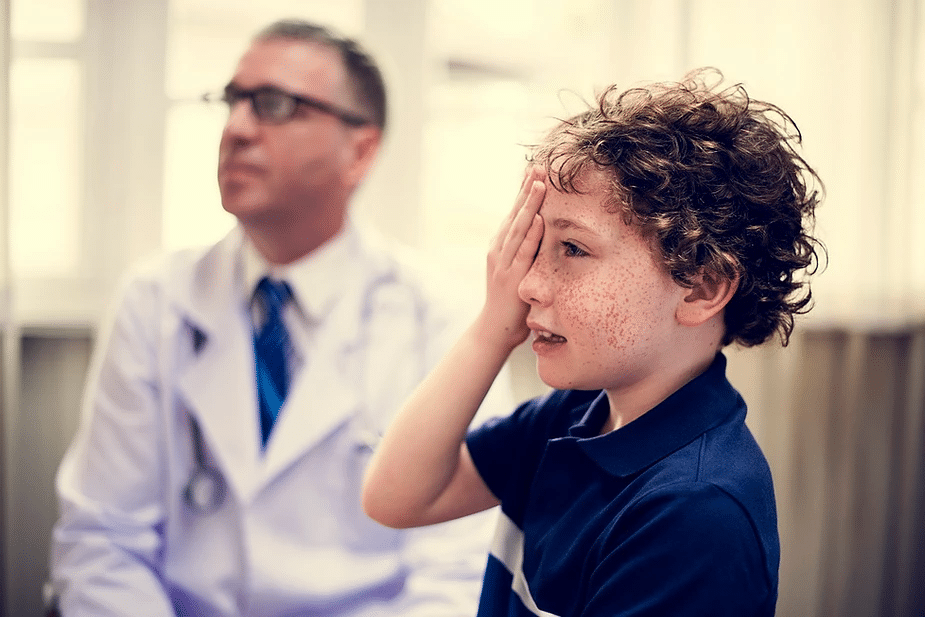Blepharitis is an inflammation of the eyelids making them itchy, swollen and crusty. The condition can occur at any age but is often experienced in childhood. It has a variety of causes but often appears alongside skin conditions like eczema and acne rosacea.
For children, the symptoms can be difficult not only because of the discomfort they cause but because they can affect their confidence in public. While the condition is chronic and often comes back, it is rarely serious and can be managed through good hygiene and treatment.
In this article, we’ll provide information about the condition and how it is best managed in children.

Symptoms and Signs in Children
Blepharitis has some distinctive tell-tale signs that you can identify in your children.
The most common symptoms are:
- Crusty or flakey eyelids
- A feeling of having something in your eye
- Soreness
- Dry eyes
- Burning or stinging
- Sensitivity to light
If your child complains of pain or soreness around the eyes it could mean several things. To identify blepharitis look for signs of swelling in the eyelids and a crust around the eyelashes. While this doesn’t appear in every case, it is one of the most common symptoms.
In any case, if your child complains of eye-related symptoms it is a good idea to book them in for a comprehensive eye exam. Catching eye conditions in children is an important part of looking after their health.
Understanding Inflamed Eyelids
Blepharitis is characterised by inflamed eyelids but the terms are not interchangeable. Inflamed eyelids may have causes like a one-off allergic reaction. On the other hand, blepharitis is a chronic condition usually caused by a bacterial or fungal infection or a problem with the oil-producing glands in the eyelids.
Inflammation is one of the body’s defence mechanisms. Increased blood flow in the inflamed area causes it to swell and become red and sore. The eyelids are a sensitive part of the body and are prone to infections, allergies, injuries and skin conditions. If you notice an inflamed eyelid in your child it could have many different causes.
An inflamed eyelid may be the first thing you notice if your child has blepharitis. It is important to have the condition diagnosed by a medical professional to properly treat it. However, later in this article, we will provide you with some tips for managing inflamed eyelids with hygiene and home remedies.
Crust on Eyelashes: A Common Blepharitis Symptom
One typical symptom of blepharitis (that you often won’t see with other cases of inflammation) is a crust forming on the eyelashes and eyelids.
Blepharitis affects the oil-producing glands in the eyelids that help to keep the eye's surface lubricated. When these meibomian glands produce oil that is thick or abnormal, this can cause a crust to form on the eyelids and eyelashes, as we see with blepharitis.
The Connection Between Blepharitis and Eczema
Blepharitis is not usually caused by eczema but the two conditions often occur together.
Eczema often occurs around the eyes, which can lead to itching and broken skin. This could be the cause of irritation in the eyes, which could exacerbate blepharitis or contribute to its development.
Inflammation and allergies are also related to both conditions. It is possible that the inflammation associated with eczema could lead to problems with the meibomian glands contributing to blepharitis.
Skin conditions are a common cause of blepharitis and often occur at the same time. Encouraging children to practice good hygiene can help to prevent conditions from leading to infection and complications like blepharitis.
Diagnosing Blepharitis
Blepharitis can be diagnosed during a comprehensive eye examination.
Because blepharitis affects the outer eye and eyelids, the examination will usually focus on those areas.
Optometrists will examine the eyelids, eyelashes and skin around the eyes. They will also look at any debris around the eyes and may swab the area to test for signs of bacterial, fungal or allergic infection. They may also test to see whether the oil-producing meibomian glands are blocked – this part of the examination may involve a bright light and magnification.
Finally, they may also examine the consistency of the tears as they can indicate how the eye is producing oil and determine whether the child may be at risk of developing dry eyes as well.
Blepharitis is best treated when accurately diagnosed early on. Having your child attend regular eye examinations and making sure any symptoms are checked out is an essential part of looking after their health.
Treating Blepharitis in Children: Effective Strategies
Once diagnosed, blepharitis can be treated in a variety of ways. The best strategy will depend on the type and cause of blepharitis so you should follow your optometrist's advice to ensure effective treatment.
Treatment options for children are similar to those for adults and involve medications, hygiene and treating underlying conditions. However, with children, it is necessary to support and assist them in taking care of their eyes. From administering medicine to making sure their eyes stay clean at school, treating your child’s condition requires a proactive approach.
Children are less likely to manage their own hygiene well, so as well as regularly helping them clean their eyes and eyelids, it’s important to encourage them to practice good hygiene on their own through frequent hand washing and avoiding contact with their eyes where possible.
Taking a child-friendly approach to eye care at home means being patient and empathetic and where possible making hygiene and treatment routines as relaxed and painless as possible. There are also many products available to minimise discomfort when washing and treating their eyes.
Treatments for Blepharitis
Treatment for blepharitis often involves a combination of medication and managing the condition at home.
Home remedies for blepharitis are aimed at keeping the eyelid clean and free from debris, soothing inflammation and minimising any blockage in the meibomian glands.
- Washing the eyelids with warm water helps to remove any crust and debris. It is recommended to use a small amount of baby shampoo and a clean cloth to thoroughly cleanse the area.
- A warm compress can be used to loosen crusts that get very dry and also helps to soothe inflammation.
- Gently massaging the eyelids can help to relieve blockages in the glands.
When a bacterial infection is present, optometrists may recommend a topical antibiotic in the form of an eye drop or ointment. For severe cases of inflammation, topical steroid treatments may be prescribed.
Treating underlying conditions like acne rosacea, allergies or dandruff can help minimise the effect of blepharitis in the long term. Similarly, making changes to your child’s lifestyle like improving ocular hygiene and having regular eye exams can make a big difference to how often they experience blepharitis symptoms and how manageable they are.
Seeking Professional Medical Advice: When Is It Necessary?
Blepharitis is one of those conditions that make it difficult to know whether professional help is necessary. It can often be treated at home and serious complications are rare. So, when should you seek medical advice?
If your child experiences symptoms that are persistent, recurring or severe you should ensure they are examined by a medical professional. This will allow them to receive an accurate diagnosis and an appropriate treatment plan.
Mild once-off symptoms may be managed at home, but when symptoms last for a long time, keep coming back or cause serious discomfort or problems carrying out tasks, it’s important to have their eyes examined.
Regular eye examinations are a crucial part of looking after your child’s eye health. If they are experiencing any eye-related symptoms, booking an eye test is the best way to get peace of mind.
Preventing Blepharitis in Children: Proactive Measures
Blepharitis is a common condition and cannot always be prevented. Nevertheless, encouraging your children to follow a few simple eye care practices and staying proactive about their eye health can help to limit their chances of getting the condition.
- Hygiene: Keeping the eyes clean is an important part of avoiding infections. Encourage your children to wash their hands regularly and avoid rubbing their eyes with dirty hands. Eye washing with a mild cleanser can also remove any bacteria and debris that could lead to blepharitis.
- Diet and exercise: Your eyes are affected by what you eat and how often you exercise. Giving your children a balanced diet rich in Omega 3 Fatty Acids, Vitamins and Antioxidants and encouraging regular exercise can help to reduce the risk of many different eye conditions including blepharitis.
- Treat underlying conditions: This is not always possible, but blepharitis is often caused or exacerbated by dandruff, acne and eczema, which can be managed in various ways. Sometimes a simple step like using antidandruff shampoo can prevent blepharitis from developing.
Proactively considering eye health and not skipping eye examinations can help in the long-term prevention of blepharitis. Including eye care in a child’s daily routine can help them avoid eye conditions and vision loss that could be a severe detriment to their well-being.

Managing Eczema and Its Impact on Blepharitis
Children with eczema are more susceptible to blepharitis and learning to manage the condition can help prevent or treat blepharitis as well.
Eczema is a difficult condition on its own and has many contributing factors. Allergic reactions to skin care products, food, weather, pollen and animals can all bring on outbreaks. Managing it can take different forms that can be discovered through trial and error with the help of a dermatologist or paediatrician, but usually involves avoiding triggers and treating the skin with topical medications and moisturisers.
Finding the correct management option for children with eczema usually takes a collaboration between the child, their caregivers and medical professionals. Managing it successfully can limit the risk of blepharitis or make it more treatable.





